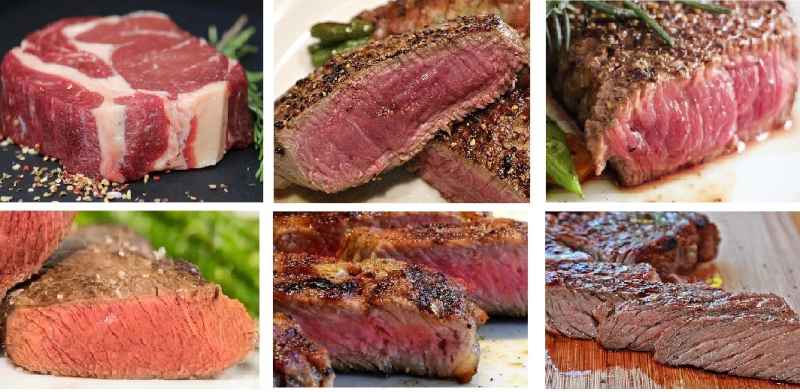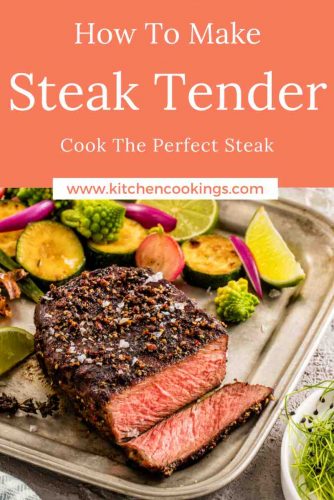To cook the perfect steak might not seem very complicated: briefly sear it, sizzle a little, let it rest for a while, then serve it. Unfortunately, it is not like that! Even the best piece of meat can be ruined too quickly by improper cooking. The individual cooking steps are critical to the consistency and taste of meat. Learn how to make steak tender and cook it perfectly.
How To Make Steak Tender – Cook The Perfect Steak
-
The Meat
When buying steaks, get the best kind of meat you can afford. A good steak should be of fine texture and feel firm under light pressure. The meat should be cherry red in color and marbled. The marbling are fine threads of fat that flow through the meat and make the steak tender and juicy.
The thickness of the steak is very important. So that the steaks are really tender and juicy, they should be about 1 inch to 1 1/2 inches thick. A steak that is cut too thin will almost certainly dry out and be tough.
-
Preparation
For the tastiest result, it is important to take the steak out of the fridge and let it come to room temperature before it goes into the pan or onto the grill.
It is also critical to pat the steak dry with a paper towel before putting it into the hot pan. If the steak is too wet, the water will boil and the meat will turn gray. Dry meat will sear nicely and develop a tasty crust thanks to the immediate onset of the Maillard reaction.
For rump steaks, cut into the fat edge so that the steaks do not curl in the pan. Don’t salt or season yet as the salt will just draw water out and pepper or seasoning will just burn in the hot pan. Salt and season the steak before serving.
-
Skillet
Use a heavy stainless steel pan or a cast-iron skillet with a thick bottom that retains heat well, a cast-iron skillet creates the most beautiful grill pattern. Do not use a nonstick coated or a Teflon pan, these are not suitable for the high temperatures. Make sure the pan is really hot before the meat goes in, it should have around 350 ° Fahrenheit. Have kitchen tongs at hand to turn the steaks.
-
Fat
Use very little fat, the actual amount depends on what kind of steak you are going to cook and how much fat the meat has. You would need a little more fat for searing a lean fillet, than for a more fat rib eye. You may just brush the steaks with oil instead of oiling the pan.
If you use fat, you have the choice between clarified butter, vegetable oil or beef tallow. Do not use pure butter or unrefined olive oil, as they have a low smoke point. Refined oils are more suitable for high heat cooking.
-
Temperatur
Make sure that the pan has a temperature of around 350 ° F before the steaks go in. This temperature is necessary for browning the meat (Maillard reaction) and for an aromatic tasty crust to form.
Only sear two steaks at a time in a normal skillet or frying pan because if there are more than two steaks the temperature may drop to much. Briefly sear the steaks, then remove them from high heat and let them rest at low heat. Maybe in the oven at a low temperature of 150-180 ° Fahrenheit. This is particularly recommended for fillet steaks.
-
Cooking Time
This is the trickiest bit of how to make steak tender and juicy. A good steak should sizzle only for a few minutes over high heat. The exact cooking time for steaks can never be exactly specified. It depends on the meat, the fat content, the thickness, the weight, and on the heat source whether it is a stove or a grill. The meat searing times given below apply to steaks of about 1-inch thickness. For each half-inch thicker give another minute each side.
-
Resting Time
For the perfect rare or medium steak, it is necessary to let it rest for a while after cooking. Letting the steak rest for a couple of minutes before serving, allows the meat juices to spread out, a critical step to make steak tender and juicy. To prevent your steak from cooling down, let it rest in the preheated oven, or wrap it in aluminum foil while it is resting. A well-done steak does not need to rest.
-
Serving
Finally, it is time to serve the steak. A warm plate is an absolute must for serving steak. After all, steak is not gobbled down quickly, but you take your time and enjoy your steak.
Steak Doneness – how to know when the steak is done?
On the outside, you want the steak well seared with a crispy brown crust full of aromatic flavors. This you can see, but the inside must be cooked to the desired steak doneness. The transition from rare to medium comes suddenly, and it takes a lot of experience to determine whether the steak is as done, as you want it to be.
Experts can use a pressure test to determine whether a steak is rare, medium or well done. An easier way for none experts is to use a meat thermometer to probe the internal temperature.
How To Make Steak Tender – The Perfect Temperature

Times are estimates; exact cooking time depends on the meat, fat content, thickness, and constant heat.
What exactly happens with the Steak when it is cooked?
When searing meat in the pan, the surface of it has to be exposed to very high heat to form a nice, tasty, and aromatic crust. At a temperature of around 380 degrees Fahrenheit, the so-called Maillard reaction sets in. Through a series of complex chemical processes, the sugars and proteins contained in the meat form new compounds and flavors, which are responsible for the brown color and the crispy crust that gives a steak its distinctive taste.
Deeper in the meat, it should only be slightly cooked by less heat depending on whether one likes the steak rare or more done. Good meat suitable for steak remains tender because it has low collagen (connective tissue) content. Meat with a high collagen content is better suitable be cooked in a slow cooker.
Careful and controlled brief searing is critical for the rosy inside of a steak to remain tender. A temperature of about 150 degrees F must not be exceeded so that the proteins that make up the muscle fibers do not denature and the collagen does not shrink.
The tenderness depends on the choice of the meat cut. Fine-textured meat with short fibers like fillet (beef sirloin) or rump steak is best for high-temperature frying or grilling. The ideal is also meat cuts finely marbled with fat and well hung. Bright red meat from the supermarket that comes from freshly slaughtered young animals is not always the best, even if it looks very nice.
A good steak should be at least 1 inch thick, a good fillet steak may even be 1 1/2 inches or more. Such a thick meat cut can be nicely seared on the outside to form a tasty aromatic crust of caramelized sugars and proteins, while the inside will still have its rosy delicate texture. A steak that is cut too thin will cook through quickly when seared and may be tough.
It is advisable to dab the meat with kitchen paper before roasting so that the surface is dry. Too much meat juice or water on the surface needs to evaporate first before the meat can sear. But as water will not heat up to more than 212 degrees Fahrenheit (100C), the surface temperature of the meat will drop too. As a result, the meat surface will simply boil and turn grey. This does not create the typical delicious flavors of the Maillard reaction. For its reaction to set in right away and nicely brown the meat and form flavors, the meat must be dry and the heat high.
Do not season or salt the steak when you prepare them for cooking. If you do this, the hygroscopic properties of the salt draw water and meat juice, drying the steak out. Always salt the steak before serving!

Cooking The Perfect Steak
As high heat is so important, you want to use a good heavy duty pan or skillet, made of highly conductive material like copper, stainless steel, or cast iron. It should have a thick bottom that can retain heat so the temperature drop is not so dramatic when the meat is put in, and searing can start right away. To avoid too much of a drop in temperature, you should also not put too many steaks into the pan at a time, rather one by one.
Heat the pan properly and only when it is hot enough do you put the steak in the pan. If you use oil or fat in it, it must, of course, be really hot too before the steak gets into the pan. The ideal oil temperature of the pan is between 350 and 365 F. Fat or oil helps transfer the heat evenly to the meat and ensures an even brown and tasty crust. Tallow, coconut fat, or a refined vegetable oil withstand the high temperatures best and are suitable.
After briefly searing both sides of the steak, remove it from high heat so the crust does not charr. Let it rest at low temperatures for a couple of minutes before serving. When it is resting, the meat juices spread evenly resulting in a juicy and tender steak.
Now its time for salt and pepper. Purists don’t like marinated meat and ready-made sauces because they falsify the real meat taste of premium steak. Marinades and sauces are used for lower quality meat.
No matter whether you prefer your steak rare or medium done. Important is a good cut of meat, the perfect cooking temperature, and just the right cooking time until it is done to the point.
Did you find this post useful, Inspiring? Save this pin to your Food and Recipe board on Pinterest. Thank You so much.
More Info:
What happens when searing meat: scienceofcooking.com/maillard_reaction.htm
The science when cooking a steak: livescience.com/44852...

